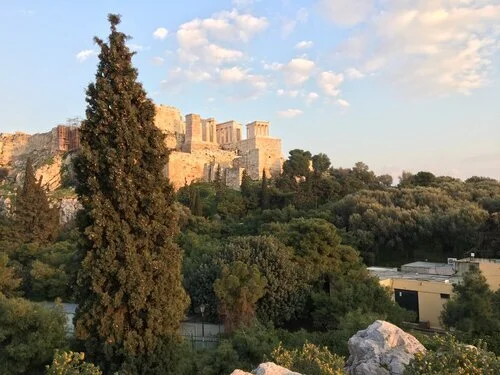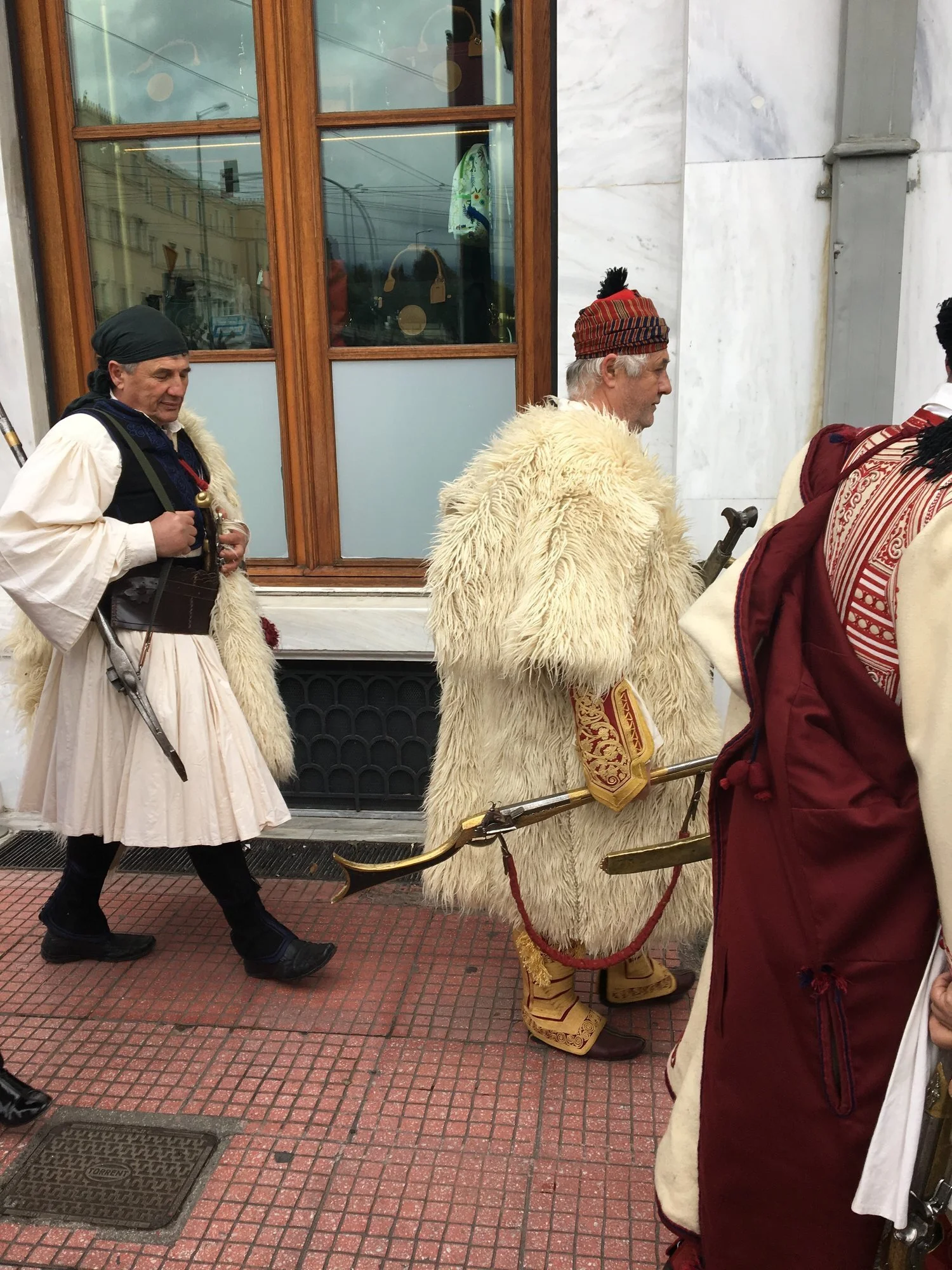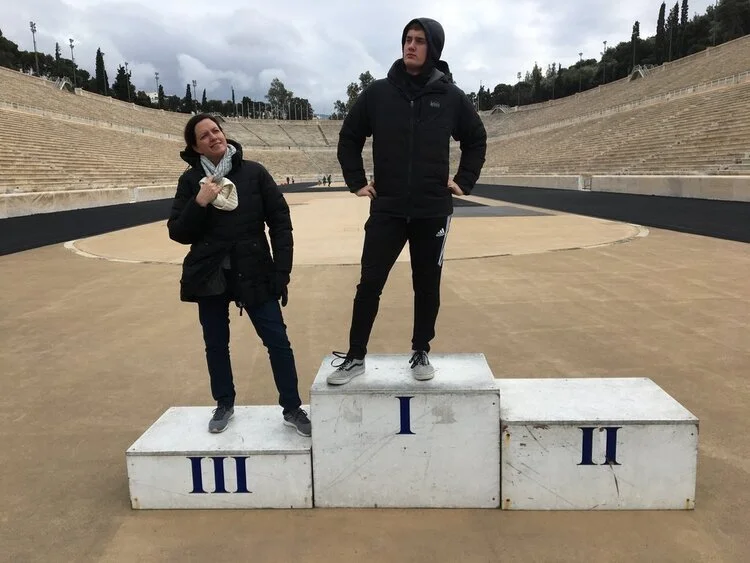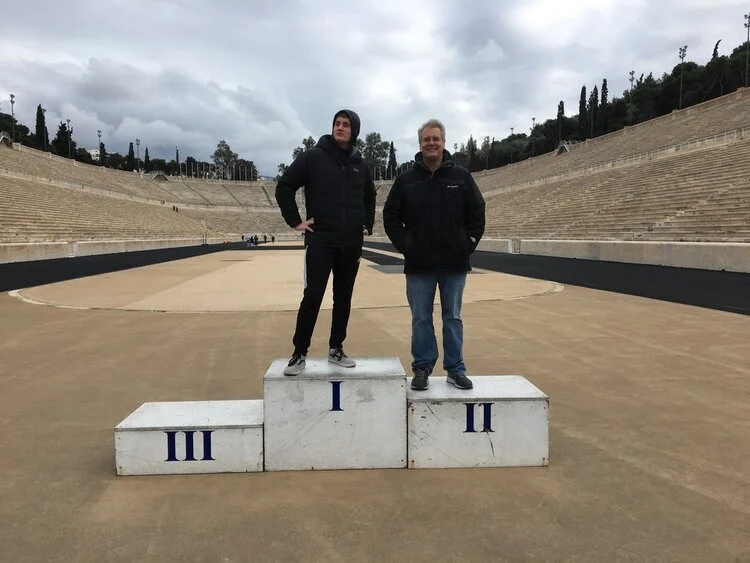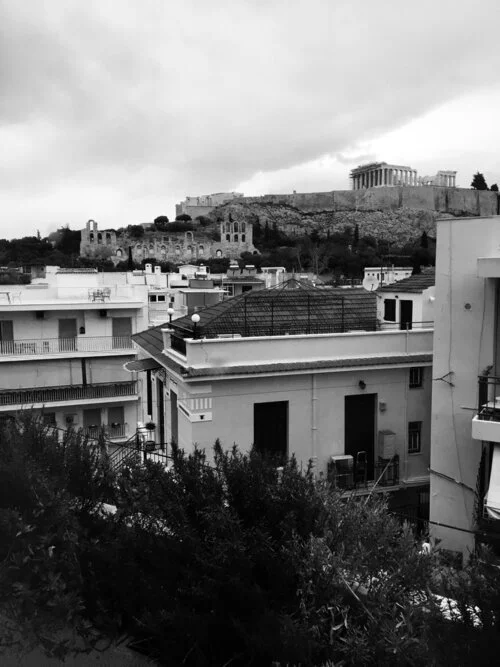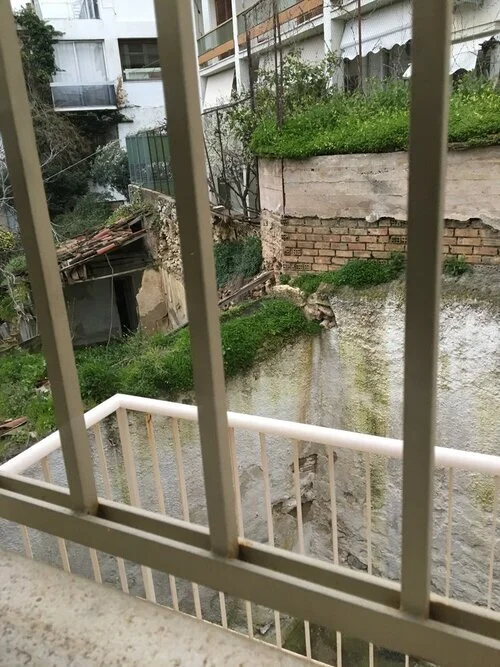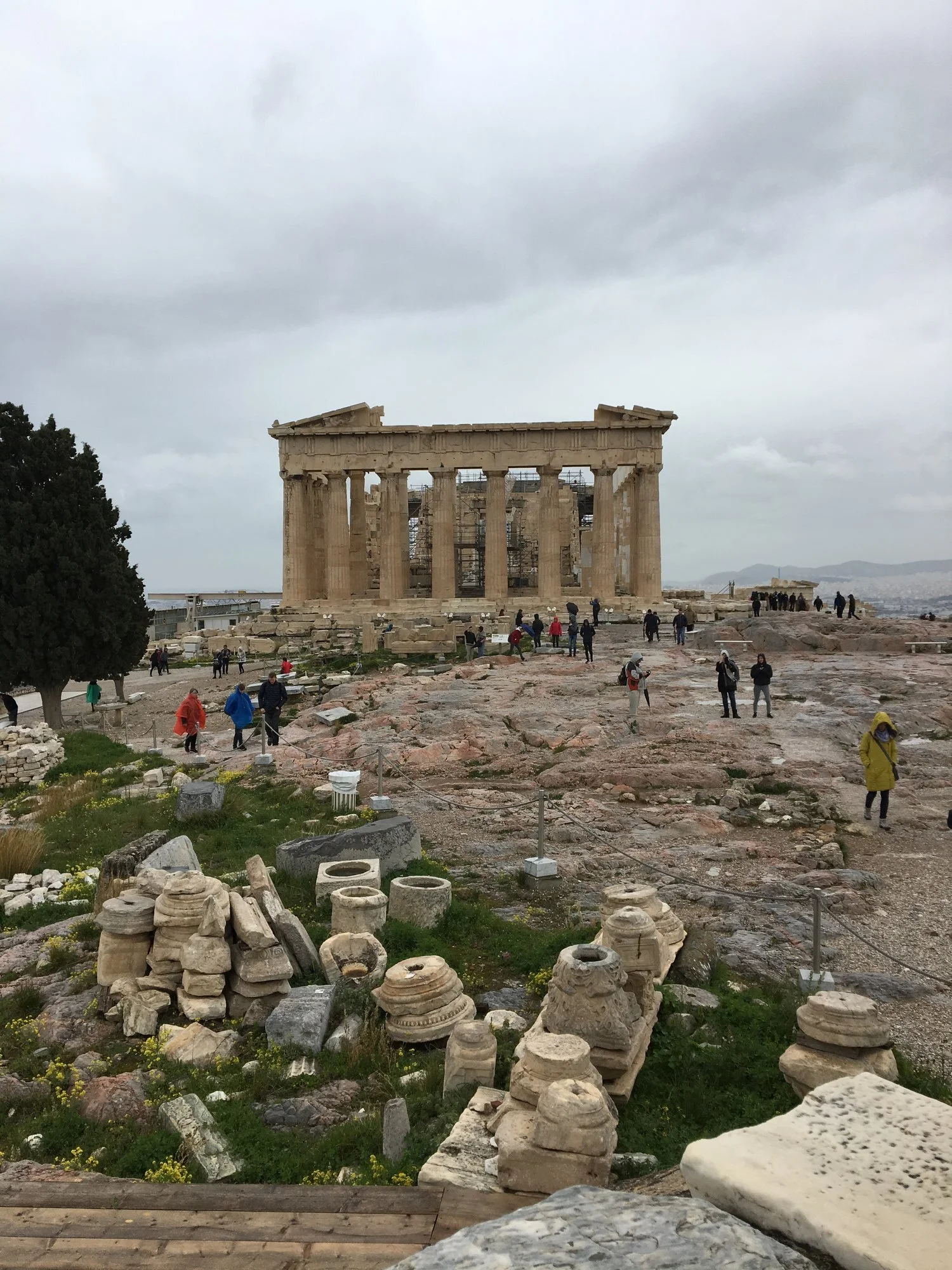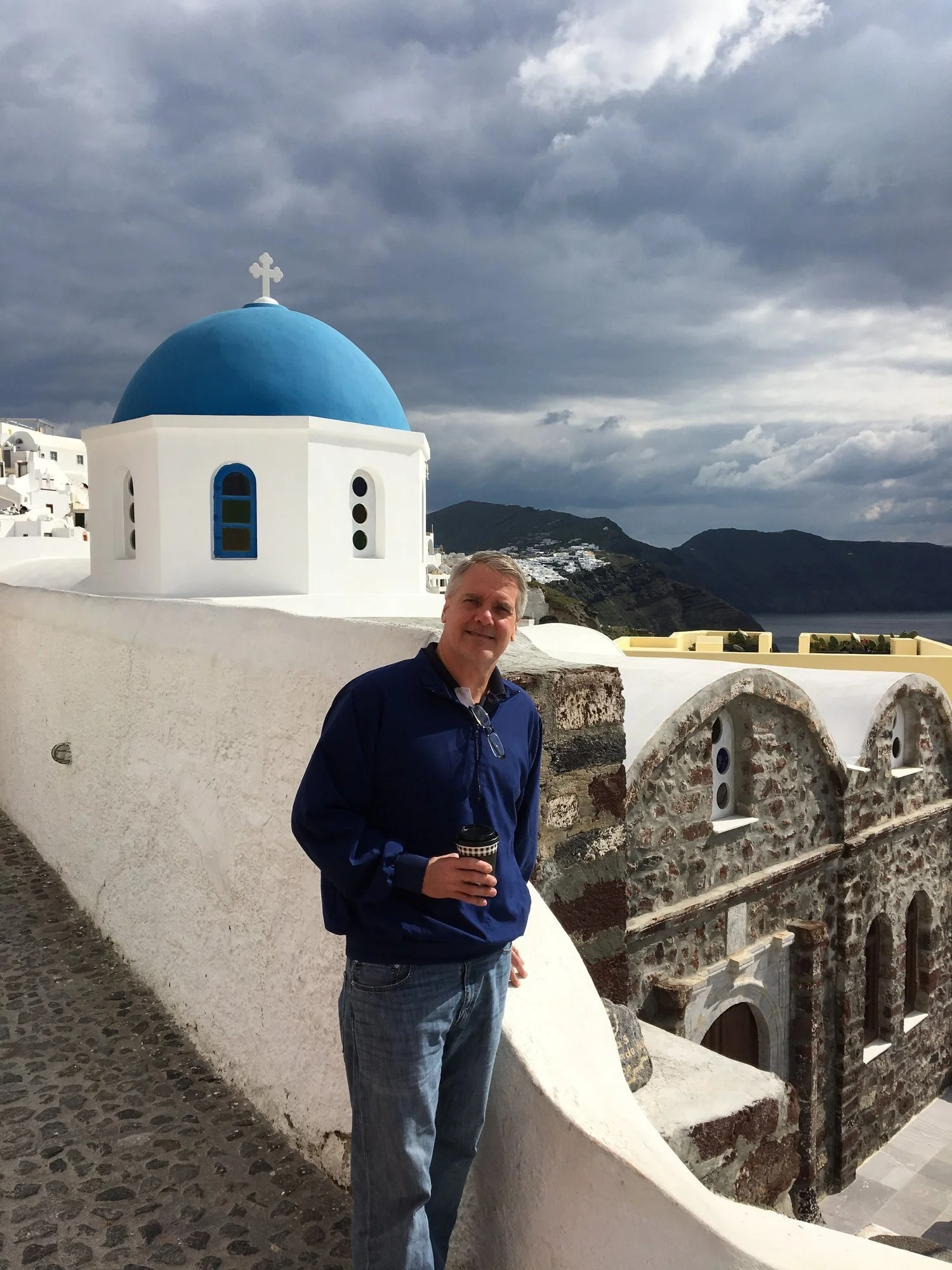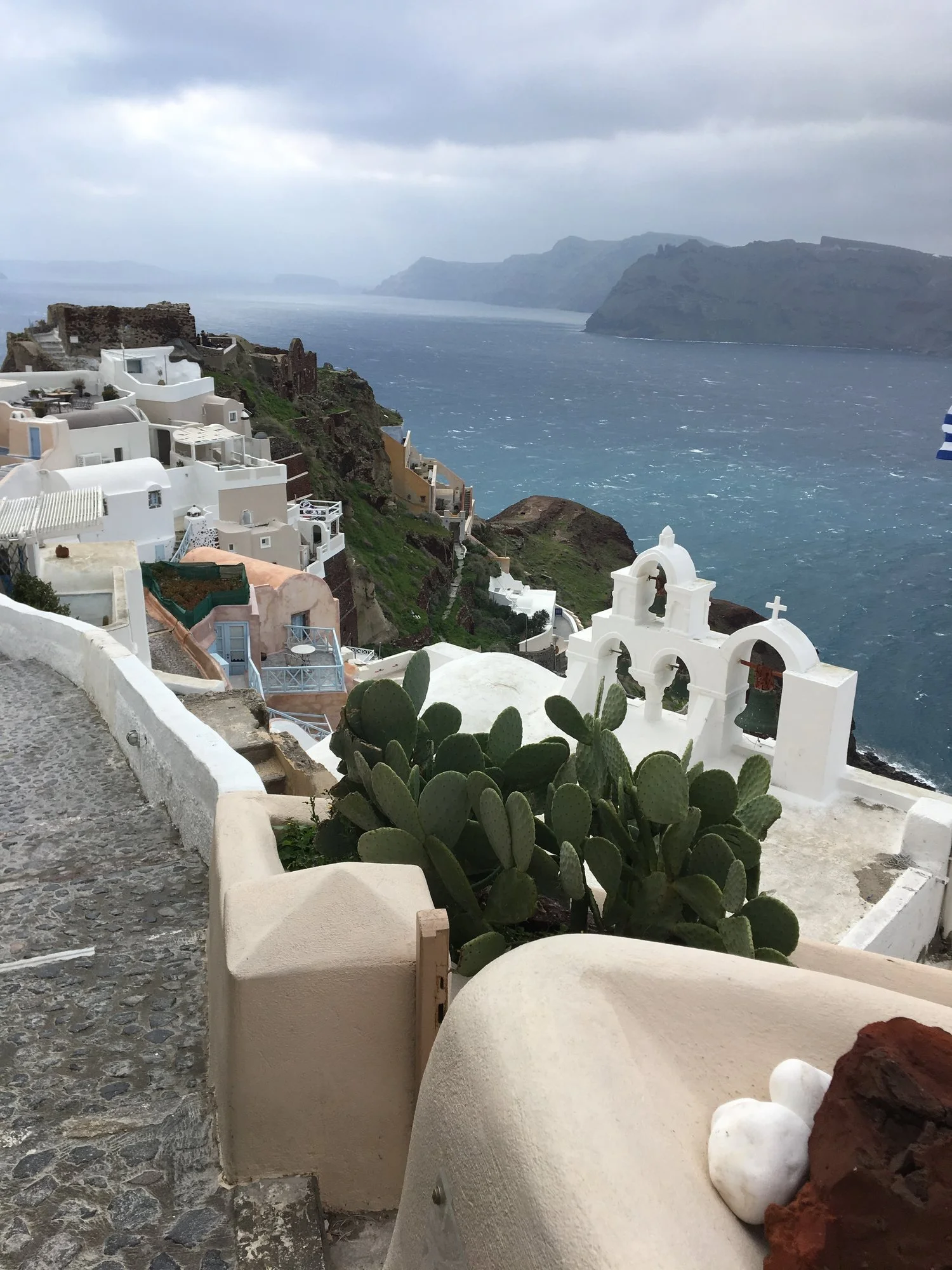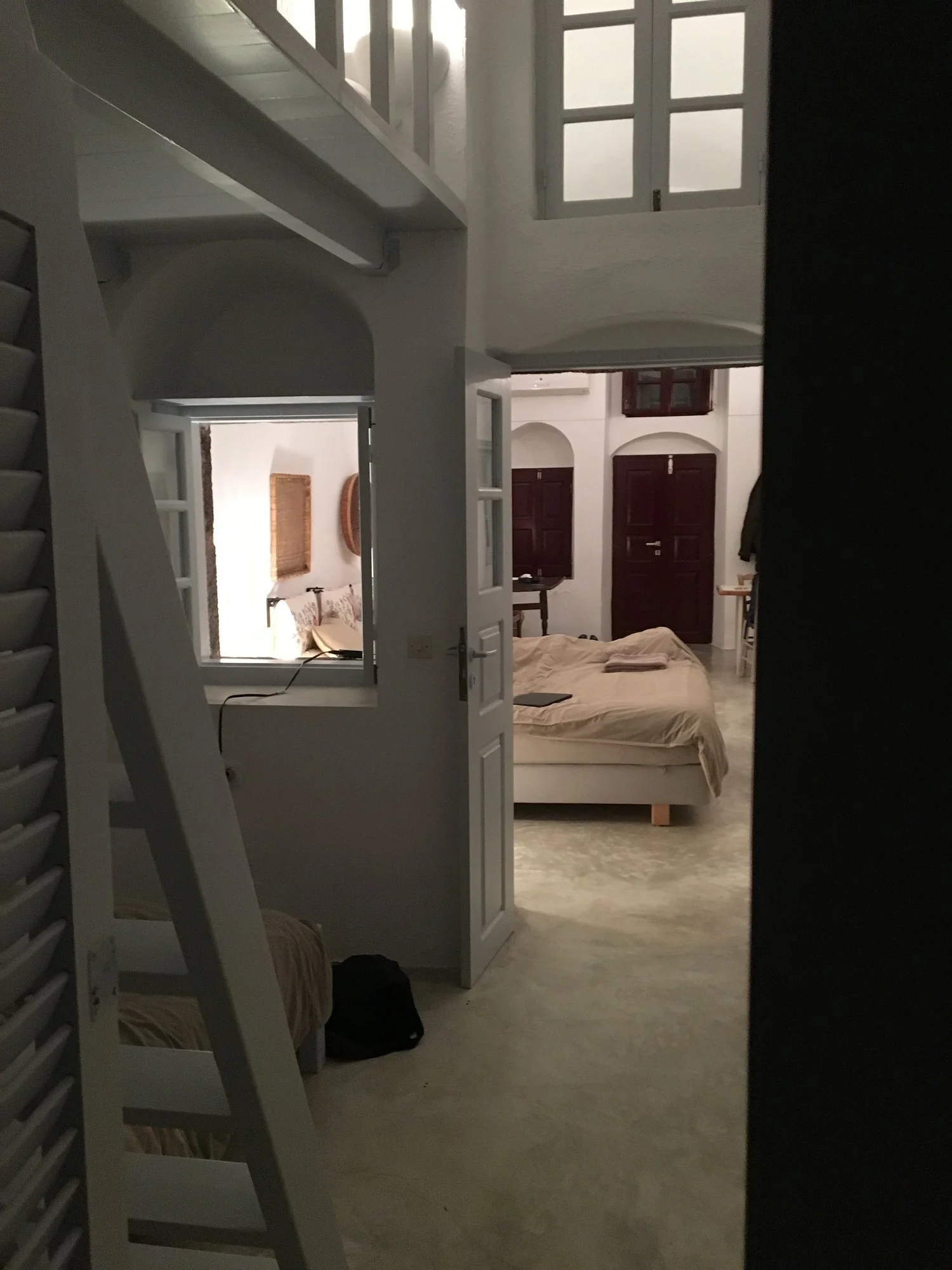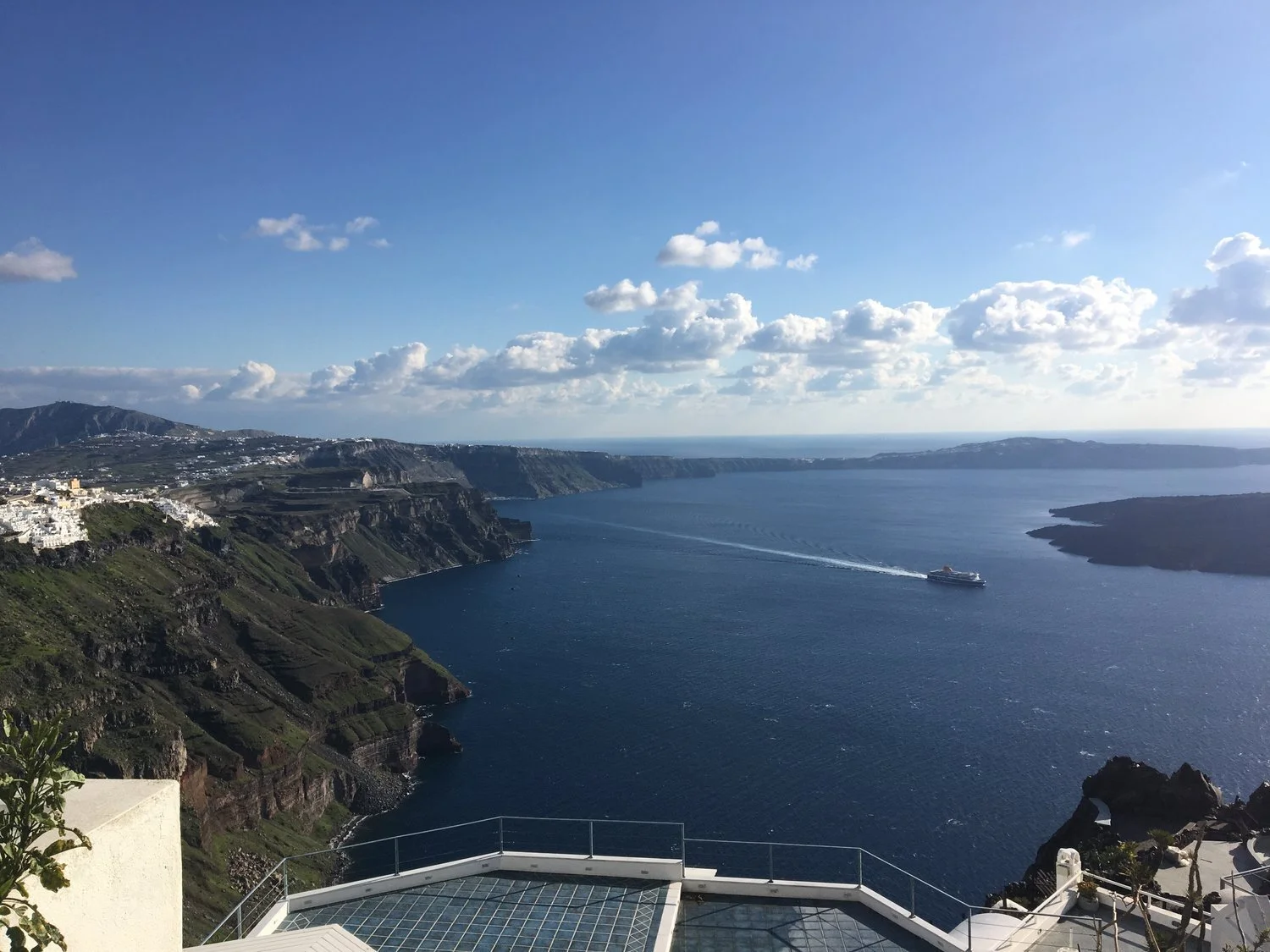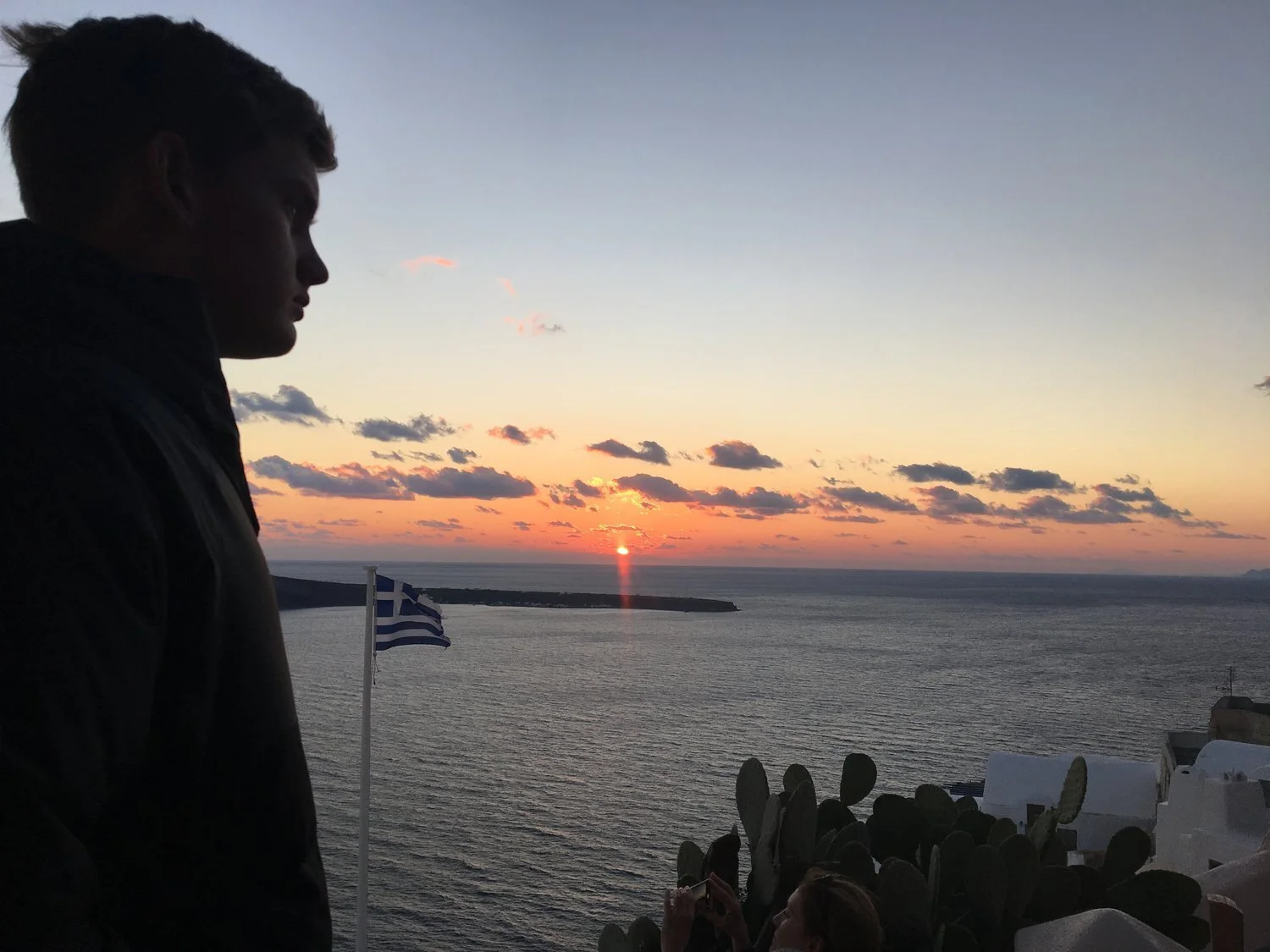Changes in Latitude Part I: Athens & Santorini
Part I: Athens & Santorini
Though the world is not as accessible now as it was when we took this trip, we can still reflect fondly on places we have been and dream about places we hope to see one day.
When vacationing on the island of Santorini, Greece, the top “things to do” are listed in every travel guide: do a boat tour of the caldera, take the cable car down to the beach in Fira, visit a winery and hike the Fira-Oia trail. We didn’t do any of those things.
It’s not that we didn’t want to do those things, it’s that we couldn’t. The guidebooks failed to mention that the island basically shuts down the last week of February (or maybe the entire winter).
Of the twenty or so restaurants on our end of the island, we found only three of them open during our visit. We were on a first name basis with the owners, and it felt like we were on a cruise ship, as we continually ran into the other guests everywhere we went.
A new friend
Another problem was the weather. I chose Greece for this vacation because we had been living in Stockholm, Sweden at that time, and were hoping for a break from the frigid weather. Having endured two months with long days of darkness, we were also craving some Vitamin D from the sunshine (see Dark & Stormy Nights). I googled “warmest places in Europe during winter,” and Greece was one of them. Unbelievably, it turned out that Stockholm enjoyed warmer, sunnier weather than Greece that week.
Despite these setbacks, we enjoyed the trip. Three of my family went: my husband, youngest son and I; none of us had been to Greece. We were happy not to suffer from jet lag since we were only one hour ahead of Stockholm’s time zone.
We started our adventure in Athens. The sun was out when we arrived, tricking us into believing that Google was right, but alas, no. We saw it briefly on the first day and once more on the last day. All the days in between were cold, dreary, and rainy.
Before dinner, we hiked up Mars Hill, right next to the magnificent Acropolis, to see the Parthenon and watch the sunset. After studying about this area our entire lives in school and church, it felt surreal to see them in real life. Much like meeting a movie star, it was hard to believe these places really existed and weren’t fictional.
View of Parthenon from Mars Hill
Mars Hill is where Paul preached the gospel to the Athenians. It was very moving to stand where one of the first Christians walked.
Where the Apostle Paul preached in Athens
The next day, we went to the top of the Acropolis to tour the Parthenon, where we were greeted by severe wind gusts and snow flurries. We stayed away from the edge for fear of being blown off (I’m not exaggerating. This was a problem other times as well - see my video clip of the top of Lycabettus Hill).
Visitors should note that it is an uneven, uphill walk to the top, with priority placed on preservation of the site and its structures rather than accessibility and safety. In addition to the wind, the Acropolis was very slippery, with loose rocks, broken sidewalks and no handrails. With that said, it was beautiful, even in its crumbling state, and the hill offered incredible, 360° views of Athens.
The Acropolis Museum was impressive. The collection of ancient artifacts was extensive. Through the glass floor below us, we could see an archaeological dig. It was strange seeing manmade items that were thousands of years old. Our son found a possible ancient ancestor.
Long lost ancestor?
The Greeks were very hospitable and made great food. We ate too much (we were on the Mediterranean Diet – where you can eat as much as you want, as long as you are in the Mediterranean region); everything was quite inexpensive compared to prices in the United States and Sweden. We even ate at God’s Restaurant.
The food was heavenly at God’s Restaurant.
On Sunday, we stumbled upon a ceremony at the front of Parliament honoring fallen Greek soldiers at the Tomb of the Unknown Soldier. We enjoyed watching the very “unique” marching style of the guards, who are called Evzones, a special unit of the Hellenic Army. Since each guard stands perfectly still for a solid hour, they move in slow motion at the changing of the guard to protect their circulation. Their short, white kilts are made with 32 yards of fabric, creating 400 folds, one for each year Greece was occupied by Turkey.
During the ceremony, a marching band with musicians in traditional folk costumes showed up, braving the freezing cold temperatures to play for the event.
Band members in traditional folk costumes.
We ran along the track of the Panathenaic Stadium, built entirely of marble in the 6th century BC, where Tom placed a distant second to our son, and I placed third.
The economic problems in Greece were evident. The very low prices were one clue, but another was the general state of disrepair of many buildings and structures around Athens. Even in the more upscale areas, graffiti was rampant and stray dogs and cats roamed the streets. The Parliament building clearly needed a face lift.
Sadly, graffiti on the beautiful buildings was a common sight.
We rented a lovely apartment on the rear side of the Parthenon, in the neighborhood of Thissio. The view from one side was spectacular: some pretty Greek apartments and a close-up view of the Parthenon. But the view from the other side of the flat was sketchy: in one area near the kitchen window, there was a decaying, slant-roofed “patio” under which stood an open doorway leading to utter darkness.
Oranges rolled around on the narrow, broken sidewalks and walkways, which were often blocked by cars parked on them. It was strange to see tropical fruit in such cold weather.
We walked home the first night after dinner, but decided to call cabs on the remaining nights, using a convenient app called “Beat.” Our first cab driver never spoke from the time we entered the car. He remained silent, listening to what sounded like a dictator droning out propaganda over the radio, until suddenly, a car nearly backed into us.
Somehow, our driver managed to avoid an accident with surprisingly quick reflexes. But his next move was a bit unsettling - he decided to back up to try to engage with the offending driver. I was ready to grab my son and dive out the side door, but fortunately the other car had driven away. Our driver clearly felt robbed of the chance to exercise retribution, cursing quietly while resuming our route. We were happy to make it back in one piece to our apartment.
Luckily, we ended our time in Athens on a higher note – eating a wonderful meal at the BG Hotel rooftop restaurant, overlooking the Parthenon. We followed that with a yummy treat at Dickie Dee’s, a local dessert spot that boasted excellent reviews on all the travel websites.
Not vaping; just eating a cotton candy ice cream cone at Dickie Dee’s.
It was almost surreal to visit and learn first hand about places we have only read about in history books. But despite all of the fun adventures and history learned, visiting Athens also felt like a spiritual journey. It was a living reminder that all of the greatest constructs and kingdoms of man will fail. Kings and rulers may reign for generations, but ultimately they fade away to history. Seeing the ruins of powerful, ancient civilizations wasn’t depressing, but a galvanizing reminder that God reigned before man started building monuments and governments, and God will reign forever after it’s all gone.
“The God who made the world…does not dwell in temples made by human hands.”
“All people are like grass,
and all their glory is like the flowers of the field;
the grass withers and the flowers fall,
but the word of the Lord endures forever.”
1 Peter 1:24-25
On day four, we arrived in Santorini, landing in strong winds, with cloudy skies and very cold temperatures. We stayed in one of the cliff-top cave houses in the village of Oia, overlooking the caldera. It was cozy and warm, and the front patio, even without sunshine, featured a view worthy of a travel magazine cover.
Each morning, we were greeted by workmen walking by with horses loaded with bags of cement, bells jingling, as they carried supplies to their many, many worksites (apparently February is also a peak construction month in Santorini).
One of the famous blue domes of Oia
Few shops were open, but I was thrilled that Atlantis Books was one of them. Often ranked as one of the top ten book stores in the world, it was definitely one of the most interesting, both in layout and inventory. The stock is carefully curated and was delightful to peruse. I chose a book about the lost civilization of Atlantis and a Greek cookbook recommended by the well-informed clerk.
The famous Atlantis Books
Santorini is one of the possible locations of the lost city of Atlantis, although it is unclear whether this ancient civilization was real or a figment of Plato’s imagination. It did feel slightly disconcerting to stay on an island that remains an active volcano. We may not know if it destroyed Atlantis, or if Atlantis was even real, but we do know that Santorini is a volcano that has destroyed whole civilizations, because we saw one of them (more later).
Life on the edge of a volcano
Ancient Minoan civilization destroyed by volcano
Our little cliff top cave
We rented a car that shifted itself into first gear on every hill, straining and jerking its way to the top of each crest. We drove around the island, exploring the ancient ruins of Akrotiri, a Minoan civilization destroyed by a volcanic eruption, and visiting the red and black beaches and little ghost towns south of us.
Hiking to the Red Beach
On the last day, we tried to hike part of the highly recommended Fira-Oia trail, but were sidetracked by a huge, gaping hole in the path, where it had fallen down the cliff due to the heavy rains. We encountered a similar hole in the road on the way to see a lighthouse one day. Deciding that we could live without seeing the lighthouse, we backed up and headed to the town of Thera to explore its winding streets. We tried to visit a famous restaurant in Thera, but it was closed for winter.
Water now fills the volcanic crater
Overall, despite weather issues, closures and construction, we had a relaxing vacation. With a pleasant mix of sightseeing and resting in our cozy Airbnb rentals to watch movies and read, we felt refreshed by the end. The morning after we returned home to Stockholm, some of our family arrived for a visit.
As soon as they settled in, four of us took off for Northern Sweden, to the subarctic region of Lapland, for another adventure. But that’s another story…check it out here Changes in Latitude II: Lulea.
The sun sets on Santorini and we begin our journey north.






